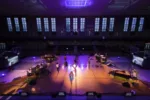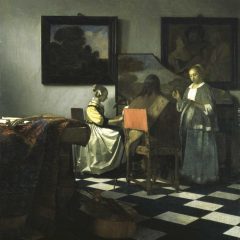Vermeer’s Masterpiece The Milkmaid at the Met (up to Nov. 29) is the kind of show the Barnes could do when it’s all moved in to the Parkway in a couple years. The show is a deep, comprehensive exploration of a work of art that also teaches a lesson about the Netherlands and other artists working at the time. The Met borrowed The Milkmaid from the Rijksmuseum and surrounded it with works by Vermeer from its own collection. Then it added Dutch genre paintings from the era that were not by Vermeer. The wall texts explain the symbolism of the milkmaid as a sexualized woman and show examples of other artists who had made the sexual innuendo a lot more front and center than Vermeer did. It is a thoroughly wonderful contextual show and the Barnes has lots of material in its collection that could be adapted to this kind of exhibition.
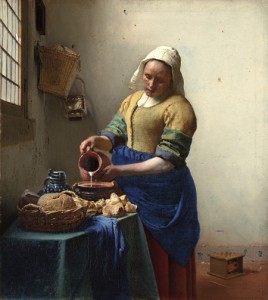
We’re not living in Albert Barnes’ lifetime anymore and today we don’t teach about art in the restrictive formalist ways that are considered “Barnes-ian.” Today, we teach the biography of the artist; the socio-political context of the art work and the significance to us today. It’s a holistic approach. Like Sue Spaid said in her post a few days ago, the PMA has a Matisse show up right now that uses this approach — it explores the work in terms of its broader implications, not just the color, composition, rhythms, etc.
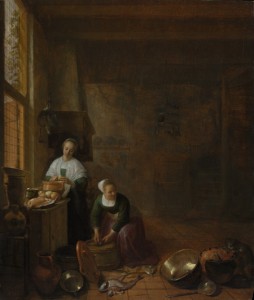
And actually speaking of Dr Barnes, we will never know if the collector — who died before his time in a car accident — would have stayed with his formalist approach to art education if he had lived longer. Maybe, maybe not. He was a mercurial character and might well have changed his tune.

Meanwhile, Roxy Paine’s Maelstrom on the Met’s rooftop, also up to Nov. 29, is also worth a shout. Like a huge group of toppled trees after a storm — only shiny like a million mirrors reflecting the sun — the stainless steel installation is a little horrifying but also beautiful. The piece takes up the entire roof top space. When the elevator attendant told us to “mind the branches” as we stepped out of the elevator I thought he was just making small talk. But actually you do have to pay attention or you’ll trip over the meandering tendrils or back up into pokey stainless steel fingers that twist every which way. The Met’s website has a 4 minute video of the artist and his team welding the piece into position. It’s worth a watch just for the heavy-industry aspect to the work (cranes; hardhats; leather gloves; sparks flying from the weldings etc). The piece wears its industrial past lightly. It’s so delicate and linear it’s like a drawing in space.
![blakeserpentarmadillo William Blake (1757–1827) Behemoth and Leviathan, ca. 1805–10 [Book of Job, no. 15]](https://www.theartblog.org/wp-content/uploaded/blakeserpentarmadillo-217x300.jpg)
And after seeing the show William Blake at the Morgan Library (to Jan. 3) I have to say Blake was an early comic book artist. In its apocalyptic fire and brimstone aspects his works are completely at one with today’s dark comic artists like Art Spiegelman, Charles Burns and others.
The show from the Library’s holdings is the first in 20 years and brings out watercolor drawings from his Book of Job (illustrating the bible story) and prints and books with his illustrations of Milton’s poetry and his own works.
The Morgan’s website has an audio clip of actor Jeremy Irons reading some Blake poetry–it’s very very nice to hear.
Patti Smith comes to the Morgan on Nov. 19 for an evening of poetry and music inspired by William Blake. The event is already sold out, but I bet it’ll be great. The Morgan has free admission on Fridays from 7-9 pm.
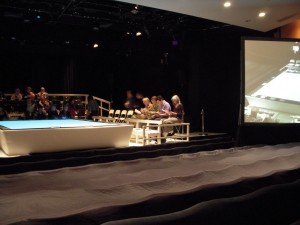
Speaking of great programming, we saw a fabulous performance, Heavenly Bento, at the Japan Society. The two person show (with a dance interlude) was an interpretive history of the Sony Corporation created by Berlin’s experimental post theatre and performed by a Japanese and a German actor and a Japanese modern dancer. The piece was a technical wow with computer animated projections on the floor of the stage and a screen projecting the action so you could watch “live” or mediated. And the story of two men and their struggle with each other and with the international world of commerce was historically interesting and told a lesson of dogged determination winning out in the end. Not too much different from standard Broadway fare, maybe. And a whole lot artier, and affordably priced as well ($18/ticket!) The production was sponsored in part by Sony so the message seemed like a brand management campaign — and I don’t know that it isn’t, but it seems everything is sponsored by corporations today, like it or not. Advanta at the PMA; Whitney’s (now gone) Altria program; Disney on Broadway, etc.
There’s a great short YouTube video of the piece on the Japan Society website that gives excerpts from the show.




